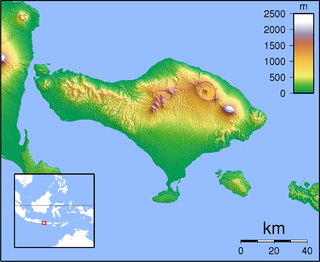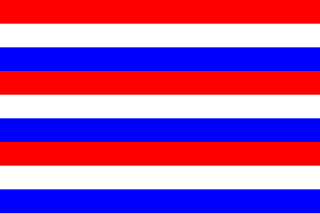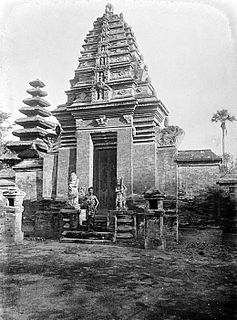
The Klungkung Palace, officially Puri Agung Semarapura, is a historical building complex situated in Semarapura, the capital of the Klungkung Regency (kabupaten) on Bali, Indonesia. The palace (puri) was erected at the end of the 17th century, but largely destroyed during the Dutch colonial conquest in 1908. Today the basic remains of the palace are the court of justice, the Kertha Gosa Pavilion, and the main gate that bears the date Saka 1622. Within the old palace compound is also a floating pavilion, the Bale Kembang. The descendants of the rajas that once ruled Klungkung today live in Puri Agung, a residence to the west of the old palace, which was built after 1929.

Puputan is a Balinese term for a mass ritual suicide in preference to facing the humiliation of surrender. Notable puputans in the history of Bali occurred in 1906 and 1908, when the Balinese were being subjugated by the Dutch.
Gelgel is a village (desa) in the regency (kabupaten) of Klungkung, on Bali, Indonesia. The village, near the coast four kilometers south of the regency capital Semarapura, contains a number of structures of cultural interest, and is known for its pottery and handwoven ceremonial songket cloth. The height of the village's power came during the kingdom of Gelgel, which dominated Bali from around the early 16th century to 1686. There are no traces left today of the old royal palace (puri). The old ancestral shrine of the ruling dynasti, Pura Jero Agung, is still standing in the old palace area. To the east of Pura Jero Agung is another old temple, Pura Dasar, which is a lowland counterpart of the "mother temple" of Bali, Pura Besakih. The village also contains the oldest mosque in Bali, which was built by Javanese retainers of the old kings.

Dewa Agung or Deva Agung was the title of the kings of Klungkung, the foremost in rank among the nine kingdoms of Bali, Indonesia. It was also borne by other high-ranking members of the dynasty. The term Dewa means "god" and was also a general title for members of the Ksatria caste. Agung translates as "high" or "great". Literally, the title therefore means Great God.

The Dutch intervention in Bali in 1908 marked the final phase of Dutch colonial control over the island of Bali in Indonesia. It was the seventh and last military intervention in Bali, following the Dutch intervention in Bali (1906).

The history of Bali covers a period from the Paleolithic to the present, and is characterized by migrations of people and cultures from other parts of Asia. In the 16th century, the history of Bali started to be marked by Western influence with the arrival of Europeans, to become, after a long and difficult colonial period under the Dutch, an example of the preservation of traditional cultures and a key tourist destination.
Babad Dalem is a historical account from Bali, Indonesia, which exists in a large number of versions of varying length. The title may be translated as "Chronicle of Kings", although the Balinese babad genre does not quite accord to Western-style chronicles. There are dated manuscripts from the early 19th century onwards, and the original version was very likely written in the course of the 18th century. The author was probably a Brahmin tied to the Klungkung Palace, the most prestigious of the nine pre-colonial royal seats of Bali.
Dalem Baturenggong, also called Waturenggong or Enggong, was a King (Dalem) of Bali who is believed to have reigned in the mid 16th century. He is in particular associated with the golden age of the Balinese kingdom of Gelgel, with political expansion and cultural and religious renovation. In Balinese historiography he represented an epic vision of kingship that served as a model for later rulers on the island.
Sri Aji Kresna Kepakisan was a king of Bali who governed the island under the suzerainty of the Javanese Majapahit Empire. He is supposed to have ruled in the mid-14th century, and to be the ancestor of the later kings of Bali. His historicity is, however, not clearly documented.
Dalem Samprangan was a king of Bali who governed under the suzerainty of the Javanese Majapahit Empire, and belonged to a dynasty of immigrants from Java. The exact dating of his reign is unclear; the sources point at either the second half of the 14th century or the early 16th century.
Dalem Ketut was a king (Dalem) of Bali who ruled at an uncertain time during the age of the Javanese Majapahit Empire. While first a vassal ruler under the Majapahit kings, he later emerged as the king of a separate island realm. He was also known under the names Sri Smara Kepakisan or Tegal Besung. Dewa Tegal Besung is the earliest deified ruler who is honoured at the Pura Padharman Dalem Gelgel, the most important shrine at the central Balinese temple Pura Besakih.
Dalem Bekung, also known as Pamayun, was a king of Bali who is traditionally dated in the second half of the 16th century. He belonged to a dynasty of kings who were descended from Majapahit on Java, and reigned from their palace (puri) in Gelgel.
Dalem Seganing was a king of Bali who reigned in the first half of the 17th century, his exact dating being still uncertain. He belonged to a dynasty which originated from Majapahit on Java, and ruled from the palace (puri) of Gelgel.
Dalem Di Made was a king of Bali who may have reigned in the period 1623–1642. He belonged to a dynasty that claimed descent from the Majapahit Empire of Java, and kept residence in Gelgel, close to Bali's south coast.
Anglurah Agung, also known as Gusti Agung Di Made or Gusti Agung Maruti, was a king of Gelgel, the paramount kingdom on Bali, who ruled at a time when the political unity of the island began to break down. This process led to the permanent division of Bali into several minor kingdoms by the late 17th century.
Dewa Cawu was a prince on the Island of Bali, who possibly reigned as king for a short while in the 1650s. He belonged to a dynasty that claimed descent from the Hindu-Javanese Majapahit Empire, and kept its palace (puri) in Gelgel near Bali's south coast.

The Kingdom of Bali was a series of Hindu-Buddhist kingdoms that once ruled some parts of the volcanic island of Bali, in Lesser Sunda Islands, Indonesia. With a history of native Balinese kingship spanning from the early 10th to early 20th centuries, Balinese kingdoms demonstrated sophisticated Balinese court culture where native elements of spirit and ancestral reverence combined with Hindu influences – adopted from India through ancient Java intermediary – flourished, enriched and shaped the Balinese culture.

Pura Dasar Buana is a Balinese Hindu temple or pura located in Gelgel, Bali, about 3 kilometres (1.9 mi) from Semarapura. Pura Dasar Buana is one of the Pura Dang Kahyangan Jagat, a temple which was built to honor a holy teacher of Hindu teaching. Pura Dasar Buana honored Mpu Ghana, a Brahmin who arrived to Bali from Javanese Majapahit to teach Hinduism in the island.






